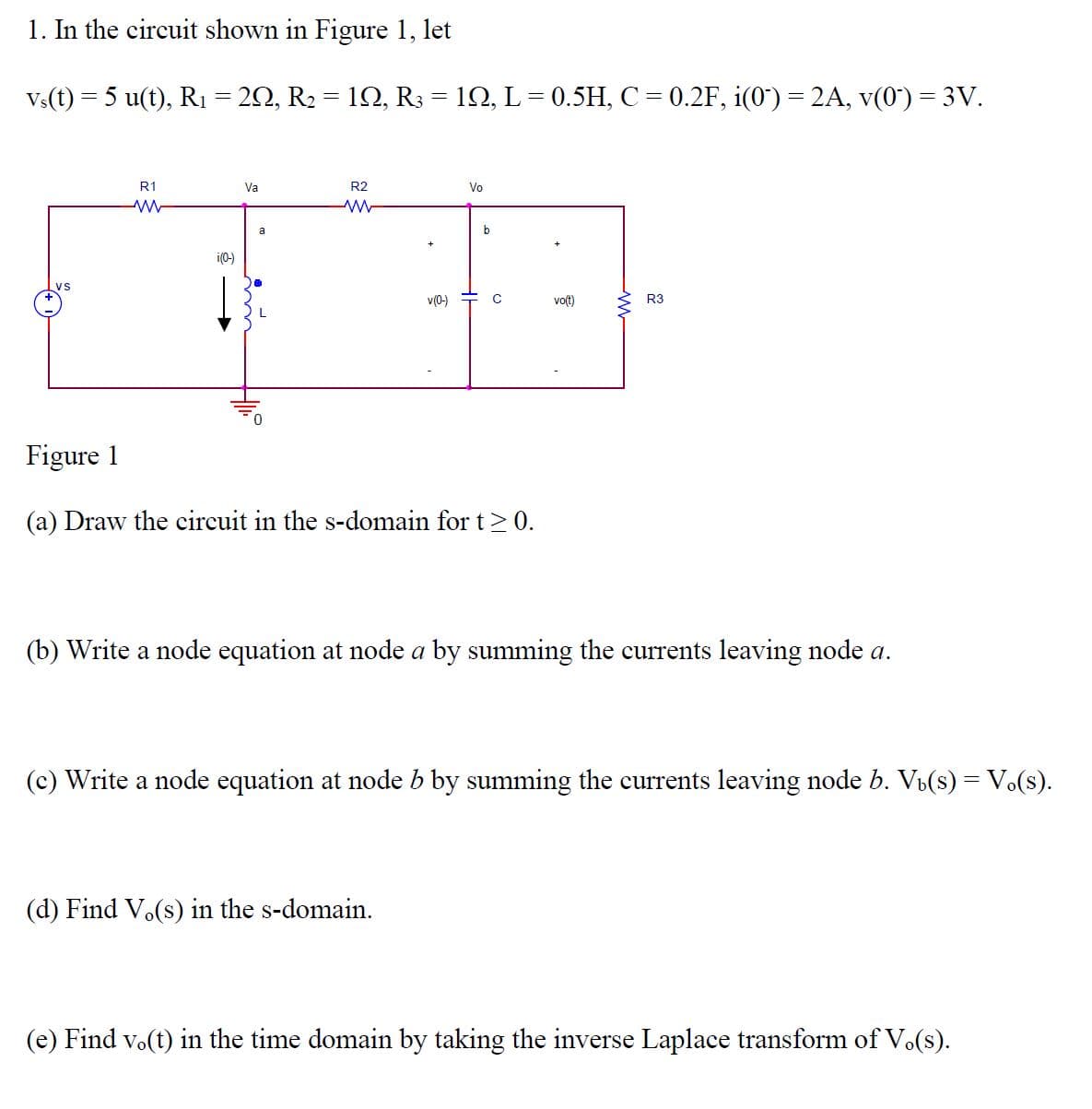1. In the circuit shown in Figure 1, let Vs(t) = 5 u(t), RỊ = 20, R2 = 12, R3 = 12, L= 0.5H, C = 0.2F, i(0") = 2A, v(0') = 3V. R1 Va R2 Vo a b i(0-) v(0-) vo(t) R3 Figure 1 (a) Draw the circuit in the s-domain for t> 0. (b) Write a node equation at node a by summing the currents leaving node a. (c) Write a node equation at node b by summing the currents leaving node b. Vi(s) = V.(s). (d) Find Vo(s) in the s-domain. (e) Find vo(t) in the time domain by taking the inverse Laplace transform of Vo(s).
1. In the circuit shown in Figure 1, let Vs(t) = 5 u(t), RỊ = 20, R2 = 12, R3 = 12, L= 0.5H, C = 0.2F, i(0") = 2A, v(0') = 3V. R1 Va R2 Vo a b i(0-) v(0-) vo(t) R3 Figure 1 (a) Draw the circuit in the s-domain for t> 0. (b) Write a node equation at node a by summing the currents leaving node a. (c) Write a node equation at node b by summing the currents leaving node b. Vi(s) = V.(s). (d) Find Vo(s) in the s-domain. (e) Find vo(t) in the time domain by taking the inverse Laplace transform of Vo(s).
Introductory Circuit Analysis (13th Edition)
13th Edition
ISBN:9780133923605
Author:Robert L. Boylestad
Publisher:Robert L. Boylestad
Chapter1: Introduction
Section: Chapter Questions
Problem 1P: Visit your local library (at school or home) and describe the extent to which it provides literature...
Related questions
Question
E and D only

Transcribed Image Text:1. In the circuit shown in Figure 1, let
V:(t) = 5 u(t), R1 = 20, R2 = 12, R3 = 12, L= 0.5H, C= 0.2F, i(0') = 2A, v(0') = 3V.
R1
Va
R2
Vo
a
b
i(0-)
v(0-)
vo(t)
R3
Figure 1
(a) Draw the circuit in the s-domain for t> 0.
(b) Write a node equation at node a by summing the currents leaving node a.
(c) Write a node equation at node b by summing the currents leaving node b. Vi(s) = V.(s).
(d) Find Vo(s) in the s-domain.
(e) Find vo(t) in the time domain by taking the inverse Laplace transform of Vo(s).
Expert Solution
This question has been solved!
Explore an expertly crafted, step-by-step solution for a thorough understanding of key concepts.
Step by step
Solved in 4 steps with 4 images

Knowledge Booster
Learn more about
Need a deep-dive on the concept behind this application? Look no further. Learn more about this topic, electrical-engineering and related others by exploring similar questions and additional content below.Recommended textbooks for you

Introductory Circuit Analysis (13th Edition)
Electrical Engineering
ISBN:
9780133923605
Author:
Robert L. Boylestad
Publisher:
PEARSON

Delmar's Standard Textbook Of Electricity
Electrical Engineering
ISBN:
9781337900348
Author:
Stephen L. Herman
Publisher:
Cengage Learning

Programmable Logic Controllers
Electrical Engineering
ISBN:
9780073373843
Author:
Frank D. Petruzella
Publisher:
McGraw-Hill Education

Introductory Circuit Analysis (13th Edition)
Electrical Engineering
ISBN:
9780133923605
Author:
Robert L. Boylestad
Publisher:
PEARSON

Delmar's Standard Textbook Of Electricity
Electrical Engineering
ISBN:
9781337900348
Author:
Stephen L. Herman
Publisher:
Cengage Learning

Programmable Logic Controllers
Electrical Engineering
ISBN:
9780073373843
Author:
Frank D. Petruzella
Publisher:
McGraw-Hill Education

Fundamentals of Electric Circuits
Electrical Engineering
ISBN:
9780078028229
Author:
Charles K Alexander, Matthew Sadiku
Publisher:
McGraw-Hill Education

Electric Circuits. (11th Edition)
Electrical Engineering
ISBN:
9780134746968
Author:
James W. Nilsson, Susan Riedel
Publisher:
PEARSON

Engineering Electromagnetics
Electrical Engineering
ISBN:
9780078028151
Author:
Hayt, William H. (william Hart), Jr, BUCK, John A.
Publisher:
Mcgraw-hill Education,